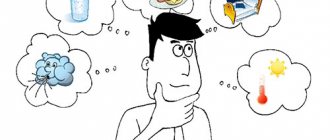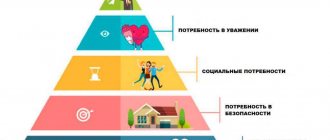Mankind knows many pyramids: the pyramids of Giza, the pyramids of Machu Picchu, the pyramids of Kukulkan and others. They are all phenomenal, each in their own way, and all arouse great interest. But in addition to these unique architectural structures, there are also pyramids of a different kind, which, nevertheless, cause far from weak excitement around them. They can be called intelligent structures. And one of them is the pyramid of needs of Abraham Maslow, a famous American psychologist, the founder of humanistic psychology.
In the online program “Self-Knowledge”, with the help of psychological tests and exercises, you will find out what you really want in life and understand your strengths and weaknesses.
Maslow's pyramid
Maslow's pyramid is a special diagram in which all human needs are presented in a hierarchical order. However, none of the scientist’s publications contains any schematic images, because he was of the opinion that this order is dynamic in nature and can change depending on the personality characteristics of each individual person.
The first mentions of the pyramid of needs can be found in German-language literature of the 70s of the 20th century. They can still be found in many educational materials on psychology and marketing today. The needs model itself is actively used in economics and is of great importance for the theory of motivation and consumer behavior.
It is also interesting that there is a widespread opinion that Maslow himself did not create the pyramid, but only identified general features in the formation of the needs of people who are successful in life and creative activity. And the pyramid was invented by his followers, who sought to clearly present the scientist’s ideas. We will talk about this hypothesis in the second half of the article. For now, let’s look at what Maslow’s pyramid is in detail.
According to the scientist's research, a person has five basic needs:
1
Physiological needs (first step of the pyramid)
Physiological needs are characteristic of absolutely all living organisms existing on our planet, and, accordingly, of every person. And if a person does not satisfy them, then he simply will not be able to exist, and also will not be able to fully develop. For example, if a person really wants to go to the toilet, he will probably not enthusiastically read a book or calmly walk through a beautiful area, enjoying the amazing scenery. Naturally, without satisfying physiological needs, a person will not be able to work normally, engage in business or any other activity. Such needs are breathing, nutrition, sleep, etc.
2
Security (second stage of the pyramid)
This group includes the needs for security and stability. To understand the essence, you can consider the example of babies - while still unconscious, they strive on a subconscious level, after satisfying their thirst and hunger, to be protected. And only a loving mother can give them this feeling. The situation is similar with adults, but in a different, milder form: for security reasons, they strive, for example, to insure their lives, install strong doors, put locks, etc.
3
Love and Belonging (Third Stage of the Pyramid)
We are talking about social needs here. They are reflected in such aspirations as making new acquaintances, finding friends and a life partner, and being involved in any group of people. A person needs to show and receive love towards himself. In a social environment, a person can feel useful and important. And this is what motivates people to satisfy social needs.
4
Recognition (fourth step of the pyramid)
After a person satisfies the need for love and belonging to society, the direct influence of others on him decreases, and the focus is on the desire to be respected, the desire for prestige and recognition of various manifestations of his individuality (talents, characteristics, skills, etc.) . And only in case of successful realization of his potential and after achieving recognition of people important to a person, he comes to self-confidence and his abilities.
5
Self-realization (fifth stage of the pyramid)
This stage is the last and it contains spiritual needs, expressed in the desire to develop as a person or a spiritual person, as well as to continue to realize one’s potential. As a result, creative activity, visiting cultural events, and the desire to develop one’s talents and abilities. In addition, a person who has managed to satisfy the needs of the previous stages and, having “climbed” to the fifth, begins to actively seek the meaning of life, study the world around him, and try to make his own contribution to it; he may begin to develop new views and beliefs.
This is a description of basic human needs. You can evaluate for yourself how true these descriptions are by simply trying to look at yourself and your life from the outside. Surely, you can find a lot of evidence of their relevance. But it should be said, among other things, that there are several controversial points in Maslow’s pyramid.
Classification of human needs
In psychology, all human needs are usually divided into three groups. This classification is quite unambiguous, since each group has very specific and obvious criteria. Let's look at each of them in detail.
Biological needs
This category includes basic needs aimed at survival, achieving physical comfort and procreation. It includes:
- delicious food (taste is important to determine freshness and nutritional value);
- clean water to quench thirst;
- comfortable living conditions;
- security and confidence in your future;
- satisfaction of sexual needs.
The listed aspirations are present in all living beings. They were formed evolutionarily to ensure the survival of the population. Essentially, they are all mechanisms that allow a person (or other creature) to survive and achieve “reproductive success” (produce offspring and ensure their survival in the future).
Social needs
Since man is a social being, he has a number of instinctive aspirations aimed at increasing his own importance in society or his group. The most illustrative examples are:
- Self-identification.
A person associates himself with his social group, while striving to recognize himself as an individual with special personal and other qualities. - Self-affirmation.
It is important for any person to be proud of their own actions and achievements, as well as to feel respect from others. - Altruism and passionarity.
Most of us derive pleasure from doing things that benefit other people or society as a whole. At the same time, self-esteem grows even if our contribution goes unnoticed by others, since for an altruist the act itself is important, and not the approval of others.
Spiritual Needs
There is a system of universal spiritual values that most people share in one way or another. We strive for moral and spiritual growth, appreciate beauty, grace of form and harmony, enjoy contemplating objects of art and listening to beautiful music. At the same time, each person has his own taste, so we all like different styles in music and styles in painting. In addition, priorities of spiritual values change throughout life.
Spiritual needs include:
- Self-actualization.
Obtaining new knowledge, expanding the range of interests and hobbies, professional growth, advanced training - these are all natural aspirations for a person who is currently not concerned with satisfying basic biological needs. - Self improvement.
As we grow up, we understand that we like to become better not in order to please someone, but simply to feel our progress. We give up smoking and alcohol, take up sports, begin to maintain a daily routine and control our stress levels. We just like to think that we're getting a little better every day. - Romantic love.
This point could be considered a manifestation of the reproductive instinct, but for us it is something much more. It is very important for us to have a loved one nearby who inspires us and gives us not only sexual but also emotional pleasure.
Spiritual needs, unlike biological and social ones, are present only in humans. Moreover, their list is not just extensive, but almost endless, since each person finds some of his own hobbies that do not have to be shared with someone else. Some people like fishing, some prefer knitting, some watch TV series, some reread The Little Prince for the hundredth time, some adore the sound of pouring rain outside the window, and some experience peace from the echoing the croaking of frogs in a nearby pond.
Theory and practice
According to many modern psychologists, despite the fact that Maslow’s pyramid is a clearly structured model, it is quite difficult to apply it in practice, and the scheme itself can lead to completely incorrect generalizations. If we put all the statistics aside, a number of questions immediately arise. For example, how dark is the existence of a person who is not recognized in society? Or, should a person who is systematically malnourished be considered absolutely hopeless? After all, in history you can find hundreds of examples of how people achieved enormous results in life precisely because their needs remained unsatisfied. Take, for example, poverty or unrequited love.
According to some reports, Abraham Maslow subsequently abandoned the theory he put forward, and in his subsequent works (“Towards the Psychology of Being” (1962), “The Far Limits of Human Nature” (1971)), the concept of personal motivation was significantly refined. And the pyramid, which many specialists in the field of psychology and marketing are trying to find application for today, has generally lost all meaning.
Criticism
The main reason for criticizing Maslow's pyramid is its hierarchy, as well as the fact that needs cannot be completely satisfied. Some researchers interpret Maslow's theory in a generally unflattering way. According to their interpretation, the pyramid suggests that man is an animal that constantly needs something. And others say that Maslow's theory cannot be applied in practice when it comes to business, marketing and advertising.
However, the author did not adapt his theory to business or advertising, but only tried to answer questions in which, for example, behaviorism or Freudianism came to a dead end. Maslow simply sought to provide insight into human motivation, and his work is more philosophical than methodological.
Advantages and disadvantages
As is easy to see, the pyramid of needs is not just a classification of them, but reflects a certain hierarchy: instinctive needs, basic, sublime. Every person experiences all these desires, but the following pattern comes into force here: basic needs are considered dominant, and higher-order needs are activated only when the basic ones are satisfied. But it should be understood that needs can be expressed completely differently for each person. And this happens at any level of the pyramid. For this reason, a person must correctly understand his desires, learn to interpret them and adequately satisfy them, otherwise he will constantly be in a state of dissatisfaction and disappointment. By the way, Abraham Maslow took the position that only 2% of all people reach the fifth stage.
What are your true needs and motives? Find out in the Self-Knowledge course.
We also recommend reading:
- Storytelling
- 6 Skills to Develop Emotional Intelligence
- Kano model for analyzing a product or service
- Self-actualization
- Abraham Maslow "Motivation and Personality" - summary
- Self-transcendence
- Pyramid of Minto. Principles
- Spiral dynamics model
- Using Maslow's pyramid for self-actualization
- Humanistic theories of personality: what to take from history to modern times
- 3 Eco-Friendly Ways to Get What You Need from Someone
Key words:1Self-knowledge
What are needs?
Need is an internal feeling of need for certain resources, circumstances or actions. Of the entire animal world, humans have the widest range of needs: from mundane physiological to sublime spiritual. Needs include all material and intangible resources, actions, circumstances and other factors necessary for a person to feel satisfied or happy.
Human needs
appear as follows:
- An unmet need is usually associated with a feeling of discomfort, anxiety, melancholy and other negative emotions.
- Satisfaction of a need is accompanied by positive emotions (both directly at the moment of its satisfaction, and when realizing that it has already been satisfied).
- There is a fixation on the subject of need. A person’s attention involuntarily concentrates on what he lacks. When we get hungry, we begin to more sensitively detect appetizing smells, and a lonely person in any circumstances looks for reasons to meet a potential “soul mate.”
Also, human needs are characterized by the following features:
- people need much more to achieve a state of satisfaction than other species;
- with age, the number of needs increases, their priorities change (a child needs much less to be happy than an adult, and for older people social and spiritual values become much more important);
- there is a completely unambiguous hierarchy of needs, and those that are of great importance can “drown out” the less important ones.
Needs are the most important motivator that forces us to act and move forward. The most basic of them force us to work to ensure our existence, and the higher ones stimulate us to development, improvement and self-actualization. All existing achievements of mankind, including inventions, scientific theories, objects of art, musical and literary works, were created under the influence of human needs.











